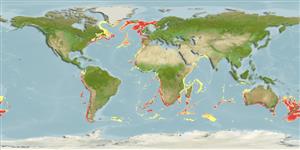>
Trachichthyiformes (Roughies) >
Trachichthyidae (Slimeheads)
Etymology: Hoplostethus: Greek, hoplon = weapon + Greek, stetho, stethion = brest; literal = to prick a little breast (Ref. 45335).
Environment: milieu / climate zone / depth range / distribution range
بوم شناسي
دريايي ناحیه ای از منطقه اقیانوسی با عمق بین 1000 تا 4000 متر. موجوداتی که در آبهای آزاد بین اعماق 1000 تا 4000 متر زندگی و تغذیه می کنند; اقیانوس رو (Ref. 51243); تغييرات عمق 180 - 1809 m (Ref. 6390), usually 400 - 900 m (Ref. 3583). Deep-water; 3°C - 9°C (Ref. 36694); 65°N - 56°S, 84°W - 168°W
Western Atlantic: Gulf of Maine (Ref. 4784) [in error according to Moore (Fishes of the Gulf of Maine, in press), should be off northern Nova Scotia]. Eastern Atlantic: Iceland to Morocco; Walvis Bay, Namibia to off Durban, South Africa. Indo-Pacific: south-central Indian Ocean and New Zealand. Eastern Pacific: Chile (Ref. 27363). Several stocks may exist as suggested by distinct spawning sites and seasons.
Length at first maturity / Size / Weight / سن
Maturity: Lm 34.5, range 18 - 32.5 cm
Max length : 75.0 cm TL جنس نر / بدون خواص جنسي; (Ref. 36696); common length : 40.0 cm TL جنس نر / بدون خواص جنسي; (Ref. 4181); بيشينه وزن گزارش شده: 7.0 kg (Ref. 36697); بيشينه سن گزارش شده: 149 سال ها (Ref. 3680)
خارهاي باله پشتي (کل) : 4 - 6; شعاع نرم باله پشتي (کل) : 15 - 19; خارهاي باله مخرجي: 3; شعاع نرم باله مخرجي: 10 - 12. Bright brick-red in color, mouth and gill cavity bluish black (Ref. 4181). Ventral scutes: 19-25.
Inhabits deep, cold waters over steep continental slopes, ocean ridges and sea-mounts. Shallow range of usual occurrence from Ref. 27121. Appears to be dispersed over both rough bottoms and steep, rough grounds where it feeds on crustaceans and fish. In New Zealand, the main prey include mesopelagic and benthopelagic prawns, fish, and squid, with other organisms such as mysids, amphipods and euphausiids occasionally being important (Ref. 9072). Juveniles feed mainly on crustaceans (Ref. 27075, 27076). Grows very slowly and is one of the longest lived fish species known. Based on parasite and trace-element analyses, orange roughy is a sedentary species with little movement between fish-management zones (Ref. 27089). Little is known of the larvae and juveniles which are probably confined to deep water (Ref. 27088). The fishery targets sporadically formed dense spawning and non-spawning aggregations. Marketed fresh and frozen; eaten steamed, fried, microwaved and baked (Ref. 9988). Because of severe overfishing the species has been listed as threatened by the Australian Government in 2006.
Orange roughy are synchronous annual spawners (Ref. 7030). They form dense spawning aggregations over sea hills and slopes. Eggs and sperms are shed into the water at the same time. Individual males appear to spawn over a 1-2 week period and females spawn for up to 1 week. Little is known of the larvae and juveniles.
Maul, G.E., 1986. Trachichthyidae. p. 749-752. In P.J.P. Whitehead, M.-L. Bauchot, J.-C. Hureau, J. Nielsen and E. Tortonese (eds.) Fishes of the north-eastern Atlantic and the Mediterranean. UNESCO, Paris. Vol. 2. (Ref. 4784)
وضعيت در فهرست قرمز IUCN (Ref. 130435: Version 2024-2)
خطر برای انسان ها
Harmless
استفاده انسانی
ماهي گيري – شيلات: با ارزش تجاري بالا
ابزارها
گزارش های ويژه
بارگيری XML
منابع اينترنتي
Estimates based on models
Preferred temperature (Ref.
123201): 3.5 - 8.4, mean 6.6 °C (based on 754 cells).
Phylogenetic diversity index (Ref.
82804): PD
50 = 0.5000 [Uniqueness, from 0.5 = low to 2.0 = high].
Bayesian length-weight: a=0.02239 (0.01605 - 0.03122), b=3.08 (2.99 - 3.17), in cm total length, based on LWR estimates for this species (Ref.
93245).
Trophic level (Ref.
69278): 4.3 ±0.1 se; based on diet studies.
جهندگی (Ref.
120179): خیلی آهسته, كمينه زمان لازم براي دو برابر شدن جمعيت بيش از 14 سال (K=0.04-0.06; tm=5-33; tmax=140; Fec=10,000).
Prior r = 0.07, 95% CL = 0.05 - 0.11, Based on 3 full stock assessments.
Fishing Vulnerability (Ref.
59153): High to very high vulnerability (72 of 100).
Climate Vulnerability (Ref.
125649): Moderate to high vulnerability (54 of 100).
Nutrients (Ref.
124155): Calcium = 12.4 [4.3, 62.9] mg/100g; Iron = 0.266 [0.095, 0.925] mg/100g; Protein = 17.5 [15.8, 19.2] %; Omega3 = 0.16 [0.05, 0.53] g/100g; Selenium = 20.4 [6.3, 69.4] μg/100g; VitaminA = 26.7 [2.7, 276.6] μg/100g; Zinc = 0.379 [0.183, 0.821] mg/100g (wet weight);
